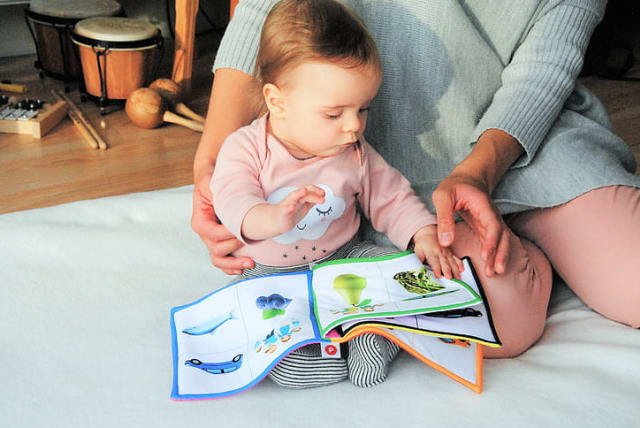Reading nursery rhymes and singing to babies can help them learn language

Babies don’t begin to process phonetic information reliably until seven months old – too late to form the foundation of language.
When parents read nursery rhymes and sing to their infants – from birth to seven months old – they are not wasting their time. Researchers at the University of Cambridge in the UK and the Trinity College at Ireland’s University of Dublin have found that these acts may help them to learn language.
Babies don’t even begin to process phonetic information reliably until seven months old – which researchers say is already too late to form the foundation of language.
Even before producing their first words, babies develop a sophisticated speech processing system, with robust word recognition present by four to six months of age. Phonetic information – the smallest sound elements of speech – may not be the basis of language learning in babies as previously thought.
Instead, babies learn from rhythmic information – the changing emphasis of syllables in speech – which unlike phonetic information, can be heard in the womb.
Parents should speak to their babies using sing-song speech, like nursery rhymes, as soon as possible, say researchers. That’s because babies learn languages from rhythmic information, not phonetic information, in their first months, suggested Cambridge neuroscientist, Prof. Usha Goswami.
Phonetic information
Phonetic information – the smallest sound elements of speech, typically represented by the alphabet – is considered by many linguists to be the foundation of language. Infants are thought to learn these small sound elements and add them together to make words.
But the new study just published in the prestigious Nature Communications under the title “Emergence of the cortical encoding of phonetic features in the first year of life” suggests that phonetic information is learnt too late and slowly for this to be the case. Instead, rhythmic speech helps babies learn language by emphasizing the boundaries of individual words and is effective even in the first months of life.
The researchers investigated babies’ ability to process phonetic information during their first year and found that phonetic information wasn’t successfully encoded until seven months old and was still sparse at 11 months old when babies started to say their first words.
“Our research shows that the individual sounds of speech are not processed reliably until around seven months, even though most infants can recognize familiar words like ‘bottle’ by this point,” said Goswami. “From then individual speech sounds are still added in very slowly – too slowly to form the basis of language.”
The researchers recorded patterns of electrical brain activity in 50 infants at four, seven and eleven months old as they watched a video of a primary school teacher singing 18 nursery rhymes to an infant. Low frequency bands of brainwaves were fed through a special algorithm, which produced a “readout” of the phonological information (relationships among speech sounds that constitute the fundamental components of a language) that was being encoded.
The researchers found that phonetic encoding in babies emerged gradually over the first year of life, beginning with labial sounds like “d” for “daddy”) and nasal sounds (like “m for” “mummy”), with the readout progressively resembling that of adults.
The first author, cognitive and computer scientist Prof. Giovanni Di Liberto at Trinity College Dublin said: “This is the first evidence we have of how brain activity relates to phonetic information changes over time in response to continuous speech.”
Previously, studies have comparthe responses to nonsense syllables, like “bif” and “bof” instead.The current study forms part of the BabyRhythm project led by Goswami, which is investigating how language is learnt and how this is related to dyslexia and developmental language disorder.
Goswami believes that it is rhythmic information – the stress or emphasis on different syllables of words and the rise and fall of tone – that is the key to language learning. A sister study conducted with adults who showed an identical ‘read out’ of rhythm and syllables to babies has also shown that.
“We believe that speech rhythm information is the hidden glue underpinning the development of a well-functioning language system,” Goswami asserted.
“Infants can use rhythmic information like a scaffold or skeleton to add phonetic information on to. For example, they might learn that the rhythm pattern of English words is typically strong-weak, as in ‘daddy’ or ‘mummy’ with the stress on the first syllable. They can use this rhythm pattern to guess where one word ends and another begins when listening to natural speech.”
“Parents should talk and sing to their babies as much as possible or use infant directed speech like nursery rhymes because it will make a difference to language outcome,” she added. Goswami added that rhythm is a universal aspect of every language all over the world.
“In all language that babies are exposed to there is a strong beat structure with a strong syllable twice a second. We’re biologically programmed to emphasize this when speaking to babies. Individual differences in children’s language originate with rhythm.”
Jerusalem Post Store
`; document.getElementById("linkPremium").innerHTML = cont; var divWithLink = document.getElementById("premium-link"); if (divWithLink !== null && divWithLink !== 'undefined') { divWithLink.style.border = "solid 1px #cb0f3e"; divWithLink.style.textAlign = "center"; divWithLink.style.marginBottom = "15px"; divWithLink.style.marginTop = "15px"; divWithLink.style.width = "100%"; divWithLink.style.backgroundColor = "#122952"; divWithLink.style.color = "#ffffff"; divWithLink.style.lineHeight = "1.5"; } } (function (v, i) { });

